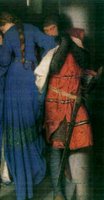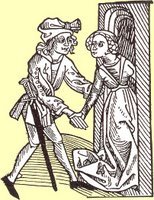
In my reading of Peter Brown's book on St Augustine the short discussion of his love travails reminded me of the following text
What is provided here is a translation of the single surviving fragment from a recently discovered, and up to this day unknown, medieval text book on the art of courtship. Philologists suggest that the title of this work was in fact Ars Amatoria, yet the present writer will call it “The rulebook of efficient courting” in an effort to avoid confusion with the famous poem by Ovid. The said manuscript (of parisian provenance) also records the first European reference to the oriental concept of the yin-yang forcing us to reassess our understanding of cultural exchanges in the high Middle Ages. As this is an unpublished text we believe that the reader is indeed privileged to find him/herself exposed to this antique wisdom. Footnotes have been kept to a minimum at an effort to allow seamless interaction with the medieval jewel. The reader will note that our fragment contains one extended and numbered paragraph covering the issue of hasty courtship.
Beginning of medieval text
1. The pitfalls of hasty courting: The desire for instant gratification will kill your chances of experiencing success in the courting ritual [i]. Success in a speeded up courting process indicates participation in human interaction, which is, in fact,
not courting but rather a mutual agreement on the exchange fluids. Courting is to be understood as a delicate dance that is undertaken between two people who harbor in their minds the idea of something more than carnal fulfillment (here we mean: in addition to carnal fulfillment, on top of it, not in transcendence of it) [ii].

Courting is then to be read as a yin-yang symbiosis, where the possibility of success is evenly matched with the possibility of failure. The little black eye in the rounded part of the white side of the whole is the measure of our capacity to read the opposite side and plan our action. It is clear then that our capacity is limited [iii]. Given this reality time is of the essence [iv]. The little eye can only be opened with better knowledge of the other. Better and deeper knowledge, as with everything in life from map-reading to cooking comes with time (or age, the relationship needs to age for knowledge to ensue) [v]. The idea that courting is an attempt at gratifying deeper personal needs makes it a process that may be undertaken ad infinitum by the more spiritually-minded, though ideally the people engaged in courting will understand that the eternal unconsumed courting leads to physical pain (known among medical circles of the university of Paris as – blue balls / les boules bleus – in the male specific version of the disease) [vi]. Thus patience a virtue, which many on this world are not known to possess, is of the essence in courting… [Here the fragment ends, to the disappointment of an eager academic crowd (vii)].

[i] Notice gentle reader the medieval author’s direct address of his readership evident in the use of “your” in the preceding sentence.
[ii] The author’s direct approach of the issue of carnal love is often a surprise to modern readers. It should, however, not be treated as such given the direct contact of people with sex from their very early years. In homes with one bed for a whole family it was hard to ignore the parental carnal-fest.
[iii] Scholarship is still at loss when trying to explain the importance of this emphasis on the white part of the yin-yang total. This emphasis on the yang, the brighter more, according to Chinese metaphysics, male component indicates for some readers the male-centric aspect of this medieval analysis.
[iv] Here language betrays the author’s metaphysical concerns. Time and essence in the same sentence perform a semantic courtship, which attempts to elevate the discussion to a more spiritual level even as direct hints of the carnality of courtship are left floating in the text.
[v] The discussion of depth is inherently sexist and highlights the male-centered perspective of the writer. Here knowledge is ultimately associated with penetration, which at the same time alludes to descent and through decent to the fall itself of humans, implicit in the fulfillment of a carnal relationship. At the same time knowledge is linked with age and experience making the art of love an art that is hierarchically structured and controlled by a crowd of elders.
[vi] The reference to Blue Balls is also one of the great recent discoveries in literature as it was previously assumed that the term was a 20th century invention, when in fact it seems that it first appears in a medieval Latin text.
(vii) This is to make a note on the sexualized nature of the modern writer’s language. The "academic crowd" is in his analysis presented as “eager,” in a manner that evidently sexualizes it and betrays the present reader’s view of academia as a massive horn-fest.
I hope you now have a better appreciation of the middle ages...
No comments:
Post a Comment